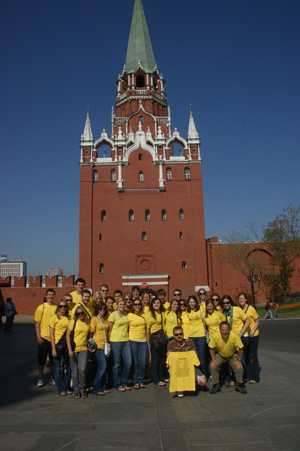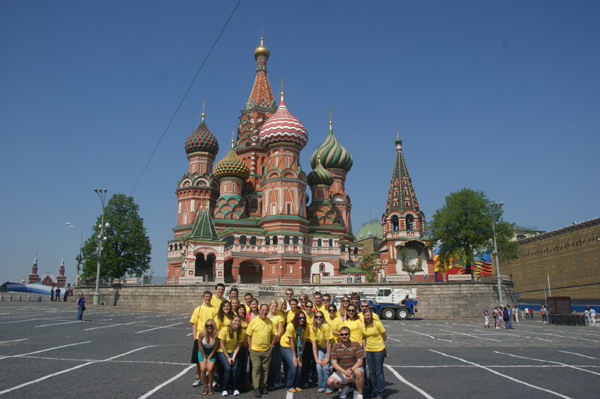
St. Petersburg — May 9, 2010
The tour of Russia began (for me) on Friday night, when I joined Prof. Vitzthum and his friends from Ruhrgas, where we’d visited earlier in the day, at a local bistro for dinner. When we were done, it was around 9 o’clock, and, far north, it was still light at 9 o’clock. Sascha suggested walking back by way of Red Square on the chance it was open . When we got there, the square was still closed, but the approaches were opened–and the Kremlin area is especially beautiful at night.
From sometime in the 12th century, the Kremlin (I think the word means fortress) has guarded (and symbolized) Moscow. Within its walls, the Russian leaders expanded the empire to the Caucasus mostly in the 18th century, to the Pacific Ocean and central Asia in the 19th, and to Eastern Europe and through the Communist International into Asia, Latin America, etc. in the 20th. The Romanov dynasty and its predecessors lived in the Kremlin until Peter the Great moved the capital (in Russian fashion, he was an absolute ruler and said he was moving to a new city–St. Petersburg, 400 miles north, providing a window to Europe that Peter looked to for inspiration). Even when St. Petersburg was the capital (until the Bolsheviks, fearing western intervention, moved the capital back to the center of the Eurasian continent), czars came for coronation and wedding to the wonderful cathedrals in the Kremlin.
Sascha and I were able to get pictures in front of the gingerbread Church of St. Basil, with its onion domes, Red Square decorated for the 65th anniversary (minus the Lenin mausoleum, buried as it were behind bunting and stands for the May 9th celebration), the famous Gum department store (which now houses western-brand boutiques), and walked around the festive area.
The next day, we went back with students. Our tour started when the Kremlin opened, and we were able to visit the Orthodox domes of the churches within, and get nice views of the whole city. The President of Russia still has offices in the Kremlin, and frequently hosts heads of state, but it’s no longer the residence of important or royal people. But, as I exclaimed, “I now can say I was in Russia,” because the Kremlin/Red Square area is one of the places that is unique–nowhere else in the world. Security was pretty tight because of the festivities and the attraction of foreign visitors; we found that out when one of the guards in the Kremlin saw us changing into our yellow trip shirts and urged (that’s a 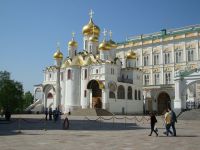 kind word) us to take the picture and change back again because otherwise people might think we were a terrorist group!
kind word) us to take the picture and change back again because otherwise people might think we were a terrorist group!
The afternoon highlight was a visit to the hills overlooking the Olympic stadia from the 1980 Olympics, which the U.S. and other countries boycotted because the Russians had invaded Afghanistan (I think there’s a lesson there!). It was a nice view of the city, and also of the famous Stalin-built Moscow University, a major high-rise that is either quasi-Gothic or quasi-gauche depending on your point of view. It’s one of seven buildings 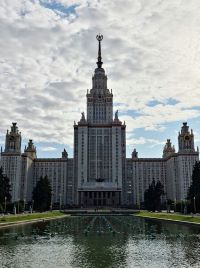 in Moscow that Stalin built in the early 1950s that are quite recognizable. One has now been converted to a 5-star hotel (a Hilton I believe); there’s one like it in Shanghai and one in Beijing, testimony to a long-buried Sino Soviet pact that fueled American fears in the 1950s that there was a communist conspiracy to surround the west.
in Moscow that Stalin built in the early 1950s that are quite recognizable. One has now been converted to a 5-star hotel (a Hilton I believe); there’s one like it in Shanghai and one in Beijing, testimony to a long-buried Sino Soviet pact that fueled American fears in the 1950s that there was a communist conspiracy to surround the west.
Our sleeper for St. Petersburg didn’t leave until nearly midnight, so we got dropped off at Old Arbat street, a kitschy-in place that when I was here in 2002 had lots of street vendors selling souvenirs, and some nice antique stores balancing the tchotchke dealers.The street has been gentrified (I’ve been to a number of streets like it, for example an old market recreation in Hangzhou).The street vendors are gone (except for painters, etc.), and one has to go into the stores for the matryoshka (the dolls within the dolls), there were bands and musicians, and great restaurants serving everything from borscht and blini to sushi (we had dinner at one that served both). It was especially suitable for people watching, which we did until it was time to go to the train station.Partly because of the holiday on Sunday, there was little traffic on the train, and we pretty much had a car to ourselves.We had four-person sleepers, with magazines (Russian Sport) and TV (Russian TV), and a rather leisurely voyage to St. Petersburg.
When we got to the city Peter dictated, we immediately went to breakfast and realized that our bus was going to be impeded by the day’s activities every bit as much as it would have been in Moscow. The parade was to start in a few hours, and the crowds gathered and the traffic got controlled. We realized when our bus had to back down a street that it was going to be an interesting day to let someone else drive.
Perhaps different than Moscow, St. Petersburg seems historically dominated by three things–the first, the effort to outdo Louis the 14th. To 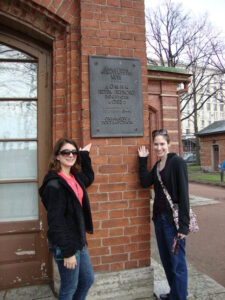 be a real ruler in Europe, one benchmarked against the Sun King in France. Hence, Peter’s efforts to build palaces that would rival Versailles, even though he was a relatively plain living man. We stopped at his cabin, conveniently across from a large souvenir shop.
be a real ruler in Europe, one benchmarked against the Sun King in France. Hence, Peter’s efforts to build palaces that would rival Versailles, even though he was a relatively plain living man. We stopped at his cabin, conveniently across from a large souvenir shop.
His daughter, Elizabeth I (?), was even more outlandish. She constructed the Summer 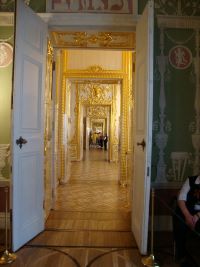 Palace which we visited. Its combination of gold and mirrors, and the famous Amber Room, are so over the top that the style is called Elizabeth Baroque, even though the baroque period had ended elsewhere in Europe. Its gardens are stunning as well, and the comparison/contrast between the richness enjoyed by the royalty, and the poverty of the peasantry always made me wonder why the Russian Revolution took over 300 years.
Palace which we visited. Its combination of gold and mirrors, and the famous Amber Room, are so over the top that the style is called Elizabeth Baroque, even though the baroque period had ended elsewhere in Europe. Its gardens are stunning as well, and the comparison/contrast between the richness enjoyed by the royalty, and the poverty of the peasantry always made me wonder why the Russian Revolution took over 300 years.
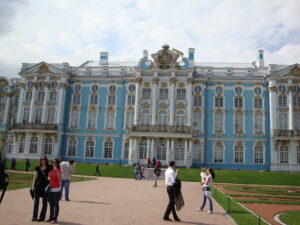 The monumental approach to architecture in particular, and its aping of Europe, makes St. Petersburg much more comfortable I think for Europeans and Americans than the larger city, Moscow. Ironically, the Summer Palace was behind German lines, and the Germans trashed it. One of the first acts of world communist leader Stalin was to pour money to rebuild this symbol of mother Russia, but Russian history is full of ironies.
The monumental approach to architecture in particular, and its aping of Europe, makes St. Petersburg much more comfortable I think for Europeans and Americans than the larger city, Moscow. Ironically, the Summer Palace was behind German lines, and the Germans trashed it. One of the first acts of world communist leader Stalin was to pour money to rebuild this symbol of mother Russia, but Russian history is full of ironies.
The second influence in St. Petersburg (and perhaps in Russia as well) is Napoleonic. While the big battles were fought closer to Moscow, and in fact  the French armies got to Moscow, there are major victory items here too. One I think is a very western-looking Church of St. Isaac, which was at one time the largest church in Russia.
the French armies got to Moscow, there are major victory items here too. One I think is a very western-looking Church of St. Isaac, which was at one time the largest church in Russia.
The third formative influence was the decline of the Romanov dynasty and the emergence of Communism in its wake. The city’s most distinctive (read Russian style) building is the Church of Spilt Blood, a colorful gem constructed in memory of the assassinated Alexander II, the most liberal of the monarchs. And of course the Russian revolutions of 1917, the first overthrowing the czar, and the second, the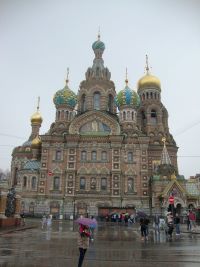 October Revolution, overthrowing the overthrowers, when the Germans allowed Lenin to return to St. Petersburg from Switzerland, and the rest is history. We saw the cruiser Aurora today, which reputedly fired the first shot of the revolution.
October Revolution, overthrowing the overthrowers, when the Germans allowed Lenin to return to St. Petersburg from Switzerland, and the rest is history. We saw the cruiser Aurora today, which reputedly fired the first shot of the revolution.
Now that I think of it–as I should today–World War II as well greatly impacted Leningrad. One million Leningraders (St. Petersburg became Leningrad during Soviet times) died in the 900-day siege; the Russians have put the death toll from World War II at 26+ million. We stopped at a memorial to the Siege of Leningrad. When you get off the train here, the first sign you see is “Heroic City, Leningrad.” We’re hoping for fireworks tonight.
One other thing about this 65th celebration. For the first time, Russians are inviting their former allies to participate in the parade. Perhaps a sign that the vision Roosevelt had for a peaceful post-war world, fostered by the allies, the United States, United Kingdom, France, China, and Russia, may be finally coming to pass. This is certainly a wealthier and less gloomy country than I remembered from my first visit in 2002. Visually, Russia has moved so far along the globalization curve (we had lunch at McDonald’s yesterday) that I was glad we were able to visit historical reminders that we’ve traveled different roads in the past. Maybe that’s why the still extant Communist Party objected to inviting the 1945 Allies!
I was told that Russia set May 9 rather than May 8 for victory day because (and they’re both possible answers): a) the peace was signed late at night which was the next day in Moscow, and/or b) the Russians wanted to celebrate the beginning of peace rather than the end of the war. Given the ensuing cold war, that wish is yet another irony in the history of a country that is very ironic.
